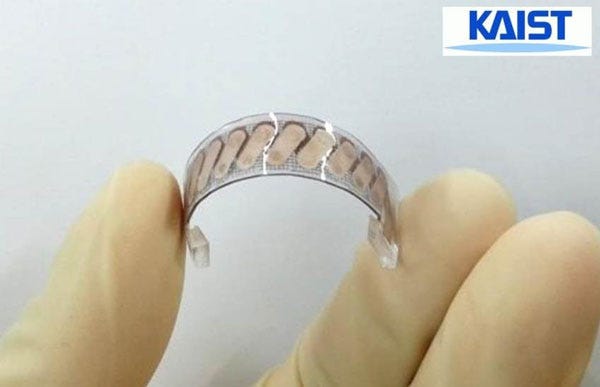Body-Heat Powered Wearable Electronics May Be Coming Soon to a Wrist Near You
April 21, 2014
|
Flexible, wearable thermoelectric generator (Courtesy Korea Advanced Institute of Science and Technology) |
A paper published by three researchers at the Korea Advanced Institute of Science and Technology (KAIST; Daejeon, Republic of Korea) has been generating considerable buzz in the wearables space. The scientists have formulated and screen printed thermoelectric generators on a flexible glass fabric.
The glass-fabric generator produces an order of magnitude more electricity than previous flexible thermoelectric generators and is said to have a bending radius as low as 20 mm. The assembled generator is sufficiently flexible to bend 120 times without losing its electrical generation capabilities, the researchers say.
Led by Byung Jin Cho, PhD, professor of electrical engineering at KAIST, the team came up with new concepts and techniques to product the fabric. First, they formulated liquid-like pastes of n-type and p-type thermoelectric compounds.
Previous wearable generators placed the positive and negative poles of the generator on a substrate, which absorbs much of the heat and therefore reduces power generation efficiency.
Cho and his team printed the poles directly between two layers of the flexible glass substrate, thus increasing both flexibility and power generation efficiency.
Cho explained in a press release, "For our case, the glass fabric itself serves as the upper and lower substrates of a TE generator, keeping the inorganic TE materials in between. This is quite a revolutionary approach to design a generator. In so doing, we were able to significantly reduce the weight of our generator, which is an essential element for wearable electronics."
Continuing, Cho describes thermoelectric power generation patches of 10 x 10 cm, about 500 ?m thick, that weigh 13 g and produce about 40 mW of power when the temperature difference between the ambient air and the wearer's skin is around 31°F. This amounts to a normal, healthy person in a room or still outdoor air at approximately 60°F, a bit chilly for most. A lesser temperature differential will produce less power.
"Our technology presents an easy and simple way of fabricating an extremely flexible, light, and high-performance TE generator," Cho says. "We expect that this technology will find further applications in scale-up systems such as automobiles, factories, aircrafts, and vessels where we see abundant thermal energy being wasted."
The team's paper, "A Wearable Thermoelectric Generator Fabricated on a Glass Fabric," was published in the Royal Society of Chemistry's journal Energy & Environmental Science. Lead author on the paper is Sun Jin Kim.
Stephen Levy is a contributor to Qmed and MPMN.
About the Author(s)
You May Also Like


.png?width=300&auto=webp&quality=80&disable=upscale)
